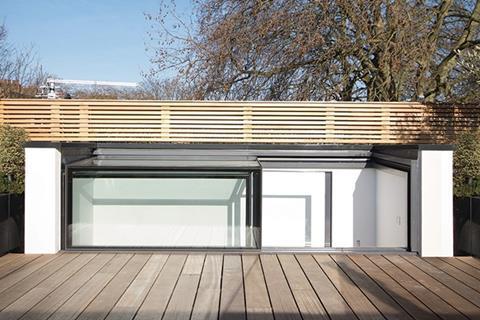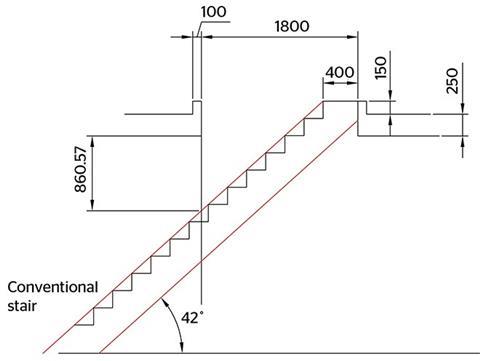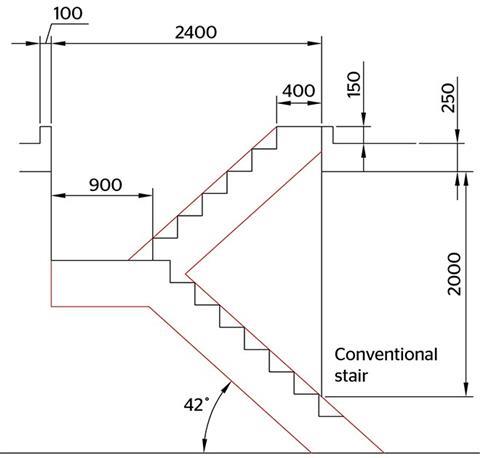Part K provides essential guidance for specifiers of access rooflights, ensuring that roofs and terraces are safe to use and maintain. This CPD, sponsored by Glazing Vision, sets out the key requirements to bear in mind

How to take this module
UBM’s CPD distance-learning programme is open to anyone seeking to develop their knowledge and skills. Each module also offers members of professional institutions an opportunity to earn between 30 and 90 minutes of credits towards their annual CPD requirement.
This article is accredited by the CPD Certification Service. To earn CPD credits, read the article and then click the link below to complete your details and answer the questions. You will receive your results instantly, and if all the questions are correctly answered, you will be able to download your CPD certificate straight away.
CPD CREDITS: 60 MINUTES
DEADLINE: 18 NOVEMBER 2016


INTRODUCTION
Rooflights provide a safe and secure means of accessing a roof and increasing usable roof space by converting flat roofed areas into terraces and roof gardens. They can also be installed to provide less frequent access to a roof area in order to complete maintenance tasks.
When considering access to a roof space, there are several factors that should be taken into account in order to comply with the ��ɫ����TV Regulations. The first consideration is why roof access is required. If it’s only for infrequent or maintenance access, the requirements will be different than if regular access is required to the space.
Once the reason for requiring access has been determined, the ��ɫ����TV Regulations will dictate how the rooflight is approached and also what safety features should be employed both in the unit itself but also on the roof surrounding the opening. For example, maintenance access may only require provision for a temporary set of ladders and a latch-way system on the roof, whereas regular access to a terrace area will most likely require a full flight of stairs and a suitable balustrade around the opening.
This CPD will explain how the ��ɫ����TV Regulations, and specifically Approved Document K, affect rooflight specification. Approved Document K supports Part K: Protection from Falling, Collision and Impact and was last updated on 6 April 2013 for use in England. The update amalgamated Approved Document N: Glazing – Safety in relation to impact, opening and cleaning, along with additional guidance from Approved Document M: Access to and Use of ��ɫ����TVs.
Approved Document K is split into a number of sections, as follows:
- K1 Stairs and ladders
- K2 Ramps and protection from falling
- K3 Vehicle barriers and loading bays
- K4 Protection against impact with glazing
- K5.1 Protection from collision with open windows
- K5.2 Manifestation of glazing
- K5.3 Safe opening and closing of windows
- K5.4 Safe access for cleaning windows
- K6 Protection against impact from and trapping by doors.
This CPD module will focus on requirements K1, K3 and K4.
REQUIREMENT K1
K1 covers the design, construction and installation of stairs, ladders and ramps. The requirement is met by ensuring that key characteristics of any stairs, ladders and ramps between levels are appropriate to afford reasonable safety to people gaining access to and moving about buildings. These characteristics include:
- gradient
- rise – the vertical portion between each tread on the stair
- going – the distance between the edge of the nosing of one step and the next
- handrails
- headroom
- length
- width.
The level of safety for access and use will depend on the circumstances but expect it to be higher in public buildings, due to the number of users and their relative unfamiliarity with the building.
Maintenance access
A lower standard of provision may be acceptable in situations where access is only required for maintenance, because greater care can be expected from those required to gain access. Where stairs or ladders are used for maintenance a minimum of once per month, you should follow provisions such as those for private stairs in dwellings or for industrial stairs and ladders in BS EN ISO 14122-3. If maintenance access is required less often, it may be more appropriate to use portable ladders, which are covered under the CDM Regulations 2007.
Regular/terrace access
Clients looking to install a method of access to a roof terrace will need to ensure that appropriate provision is included in their scheme. Guidance on what is deemed appropriate will vary depending on the scheme and a local ��ɫ����TV Control officer should be consulted prior to any works. However, it is widely accepted that a permanently installed flight of stairs offers the most appropriate solution for those looking to access a roof terrace via a rooflight or any other means.
Minimum head height
Head height is almost certainly one of the key issues when it comes to moving between levels in a building and Approved Document K offers guidance to ensure that a specifier’s desired product will be large enough and include the correct features to allow safe passage. For a private stair, a minimum headroom of 2m is adequate for access between levels, with a maximum permitted pitch of 42˚. When combined with the roof thickness, which can be considerable when structural load and insulation are taken into account, care should be taken to make sure that the opening in the roof and the rooflight itself achieves the required 2m.
Fig 1

Fig 1 shows that a typical flat rooflight with a 2m external dimension and a 1.8m internal dimension cannot be used for regular access to a roof terrace with a conventional stair and comply with Part K. This drawing shows a stair with the minimum going of 220mm and a short landing area of 400mm providing a headroom of only 860mm.
It should also be noted that this example has a very slim roof construction of only 250mm. It is likely that most roof constructions would be deeper than this and this dimension will directly affect the head clearance achieved. This also takes no account of the height of the frame profile of the rooflight itself.
Fig 2

Fig 2 demonstrates that, to comply with Part K, the minimal internal opening needs to be 3,065mm. This example still has a very slim roof construction of only 250mm – for every additional 50mm on the depth of the roof construction an additional 56mm will need to be added to the length of the opening to maintain compliance.
This also takes no account of the height of the frame profile of the rooflight itself. This is the only compliant solution where the width of the rooflight is no greater than the width of the stair.
Fig 3

Fig 3 shows that where the width of the opening is sufficient to accommodate double the stair width and thus a landing, the minimum internal length of the rooflight reduces to 2.4m based on a 900mm landing.
To comply with Part K, the landing must be at least the same as the width of the stairs. The suggested minimum width of stairs in England is 800mm although in some circumstances this may be as little as 600mm – this should be checked with the local building control office.
Close relationships with product manufacturers are incredibly important as they can offer guidance on size limitations and material specifications. Glass rooflights, for example, can become more complex to open in larger sizes due to the sheer weight of the material.
Box rooflights
Box rooflights add head height above the internal ceiling level, and if designed correctly can provide the desired clearance for access. These rooflights tend to function using a sliding mechanism rather than a hinge, so the stair must be carefully positioned so that the threshold coincides with the rooflight in the open position. In most cases, box rooflights are operated at a distance either by remote or wall-mounted control unit or remote, so they should already be partially open while ascending the stair.
Landings for stairs
Part K offers guidance in relation to the minimum requirements for both rise and going of steps for permanent flights of stairs. For access rooflights the final step should be considered a landing as it appears at the top of the flight of stairs in accordance with Section 1.20 Landings for stairs (for all buildings). A 400mm minimum tread width should be in place at the top of the flight of stairs where the user would exit on to the roof.
Tapered treads
Installing a flight of stairs in a dwelling incorporating tapered treads is permissible and covered under “Special stairs” in Approved Document K. The rise and going should be designed with the usual requirements and comply with guidelines detailed in Paragraph 1.2 and 1.3 of the document, but for the going of tapered treads you should consult Diagram 1.9. If you are planning to use consecutive tapered treads then the going will be the same on each but for those considering a stair consisting of both straight and tapered treads, then the going of the tapered tread should not be less than that of the straight tread. The going should be measured at the centre of the tread and a minimum width of 50mm should be provided at the narrow end.
Alternating tread stairs in dwellings
In some cases there simply may not be enough space to accommodate a full flight of stairs and section 1.29 of Approved Document K covers the potential scope for the use of “alternating tread stairs”. Alternating tread stairs can save valuable space and be installed at a steeper pitch, but Part K only recommends their use for loft conversions, when there is not enough space for a full flight and the stairs provide access to only one habitable room.
This type of stair should be considered a last resort: budgetary considerations are highly unlikely to be accepted by ��ɫ����TV Control as justification for their use. Use in a loft conversion with a single habitable room is justified by the limited use and the number of people likely to be using the stair at any one time.
The number of people using a roof terrace would normally be more than those requiring access to a single habitable room in a loft conversion. Approved Document K does not cover roof terrace access specifically but advice from LABC states that in its opinion an alternating tread stair is of limited use and would not satisfy the requirements of Part K under general circumstances. It recommends that the specifier seeks advice from their local ��ɫ����TV Control Officer if they are considering alternatives to a full flight of stairs.
Construction of steps
K1 also covers construction of steps and states that, for all buildings, the rise and going of each step must be consistent throughout the flight of stairs. It also states the benefits of installing steps with risers, noting that:
- it removes the possibility of the front of a foot or walking aid being caught underneath a tread during ascent, possibly causing a fall
- it avoids the feeling of insecurity people get when looking through open risers on the stair.
Section 1.9 specifically refers to dwellings and states that steps may have open risers provided:
- they overlap treads by a minimum of 16mm
- a 100mm diameter sphere cannot pass through the open risers.
In many cases, installing a flight of steps with open risers in conjunction with rooflight installations overhead can increase the amount of natural daylight available in the stairwell.
REQUIREMENT K3
K3: Guards and Barriers covers several areas where safety barriers may be required. With regard to rooflight installations it specifically refers to pedestrian guarding to protect the edges of any part of a roof. In single-family homes and residential buildings the minimum height for such elements is 900mm on stairs, landings, ramps and edges of internal floors and 1,100mm for external balconies and edges of the roof.
For roof terraces where the sole means of access is via an opening rooflight, a barrier may be required around the opening to prevent users from falling through. This will depend on product selection, how the rooflight operates and its orientation on the roof in relation to the building fabric.
Rooflights as safety barriers
Hinged access rooflights can still be safely used with minimal barriers if the scheme and layout of the building permits and the orientation of the rooflight is considered carefully.
The opening section of the rooflight can be used as a safety barrier in the fully open position provided that it meets the minimum size criteria in Approved Document K and that the glass is compliant with Approved Document N.
Removing the need for safety barriers
Box rooflights are a solution that avoids the need for barriers or balustrades. As these products are constructed as a physical structure, the glazing of the rooflight itself forms a barrier.
REQUIREMENT K4
Protection against impact with glazing
The materials used, particularly the glass itself, must still comply with the ��ɫ����TV Regulations in respect to their design and reference should be made to K4: Protection against Impact with Glazing. This states that any glazing with which people are likely to come into contact while moving in or about the building shall:
- if broken on impact, break in a way which is unlikely to cause injury; or
- resist impact without breaking; or
- be shielded or protected from impact.
In order to meet this requirement, in critical locations one of the following approaches would be accepted:
- measures to limit the risk of cutting and piercing injuries by the use of glazing that is reasonably safe, such that, if breakage did occur, any particles would be relatively harmless
- use of glazing sufficiently robust to ensure that the risk of breakage is low
- steps taken to limit the risk of contact with the glazing.
In the case of rooflights, the most common solution is to use toughened safety glass designed to fracture into smaller less harmful pieces in the event of breakage. Some manufacturers offer higher specification heat-soak-tested toughened safety glass in order to reduce the risk of nickel sulphide inclusions forming during the toughening process, which has reportedly led to spontaneous glass fractures.
Another option would be to specify glazing with a laminated interlayer designed to hold any fractured sections of glass intact. This prevents them falling out of the frame and causing injury.

How to take this module
UBM’s CPD distance-learning programme is open to anyone seeking to develop their knowledge and skills. Each module also offers members of professional institutions an opportunity to earn between 30 and 90 minutes of credits towards their annual CPD requirement.
This article is accredited by the CPD Certification Service. To earn CPD credits, read the article and then click the link below to complete your details and answer the questions. You will receive your results instantly, and if all the questions are correctly answered, you will be able to download your CPD certificate straight away.
CPD CREDITS: 60 MINUTES
DEADLINE: 18 NOVEMBER 2016
Privacy policy
Information you supply to UBM Information Ltd may be used for publication and also to provide you with information about our products or services in the form of direct marketing by email, telephone, fax or post. Information may also be made available to third parties. UBM Information Ltd may send updates about ��ɫ����TV CPD and other relevant UBM products and services. By providing your email address you consent to being contacted by email by UBM Information Ltd or other third parties. If at any time you no longer wish to receive anything from UBM Information Ltd or to have your data made available to third parties, contact the Data Protection Coordinator, UBM Information Ltd, FREEPOST LON 15637, Tonbridge, TN9 1BR, Freephone 0800 279 0357 or email ubmidpa@ubm.com. View our full privacy policy at






















1 Readers' comment